Welcome to DU!
The truly grassroots left-of-center political community where regular people, not algorithms, drive the discussions and set the standards.
Join the community:
Create a free account
Support DU (and get rid of ads!):
Become a Star Member
Latest Breaking News
General Discussion
The DU Lounge
All Forums
Issue Forums
Culture Forums
Alliance Forums
Region Forums
Support Forums
Help & Search
Celerity
Celerity's Journal
Celerity's Journal
May 1, 2024

The Heritage Foundation’s Racist Origins and What That History Tells Us
https://washingtonspectator.org/heritage-foundations-racist-history/
CRENSHAW: These wars on curricula are not new, of course; they go far back in our history. What folks might not know is that the Heritage Foundation, the main convenor of Project 2025, cut its teeth on curricular wars in the 1970s. Can you tell us about this formative history and what it reveals about the sort of organization Heritage and its 2025 partners are?
MacLEAN: The Heritage Foundation today is the 800-pound gorilla on the radical right. With an annual budget of over $100 million, and a huge, multistory office complex in Washington, D.C., it is one of the top agenda-setting organizations on the right, if not the dominant one, so it’s not surprising that it took the lead in creating Project 2025. What people need to know is that—unlike some other groups on the right—from its outset the Heritage Foundation blended the toxic cocktail that today’s right is gulping in large doses to achieve its goals: libertarian economics; Christian nationalism; and the weaponization of racism, gender anxiety, and parental fears about sex. Back in 1974, a year after its founding, Heritage had a staff of five people in a rented office above a garage. That’s when its co-founder, Paul Weyrich, sniffed a big opportunity in West Virginia—in a textbook fight brewing in Kanawha County, home of the state capitol in Charleston. As Weyrich said later: “The alliance between religion and politics didn’t just happen.”
Heritage worked hard to make it happen. Heritage’s then-tiny team inserted itself in a fight opened by Alice Moore, a school board member, and the wife of a fundamentalist minister. She didn’t like the new multicultural language arts textbooks the district was adopting that including some 300 titles she had not read but objected to. First, she complained about literature that had any dialogue, whether Appalachian or “ghetto,” that was not “correct” English. Then it was that the books were “filthy, disgusting trash”— also “unduly favoring blacks.” Then it was that The Autobiography of Malcolm X, an option for high school seniors, disrespected Christianity. As with today’s culture wars, this one had interested backers from the beginning. Moore was already in the orbit of the John Birch Society and received counsel from Mel and Norma Gabler, the Texas-based couple who were transforming textbook adoption in states like their own by claiming bias over what they viewed as offensive content, such as evolution rather than creationism. Moore soon traveled to address the Christian Crusade of Tulsa on the theme “Public Schools Undermine God’s Law.”
All the while, the fledgling Heritage Foundation provided training, publicity, and links to potential allies. The result? The most violent textbook battle in U.S. history to date. Over the ensuing months, parents of one-fourth of the students in the county had kept them home to boycott the schools, some set up private “Christian schools,” gunshots were fired, Moore’s allies physically attacked supporters of the new curriculum at a school board meeting, and arson and bombings caused several schools to close. Some local protesters cut right to the chase and denounced the new recommendations as “n—–r books.” (From the start, the NAACP saw the all-white campaign against the new books as racist). As Maya Angelou once wrote: When people show you who they are, believe them—the first time. Because what Heritage showed then is that it would bring gasoline to any fight that would help to build a bench of reactionary religious voters—a strategy which was still in its earliest stages of development. And they would not blink at violence if it seemed to help their cause. Heritage provided legal counsel to a Christian minister, Marvin Horan, who was charged with plotting school bombings. Moran was convicted and sentenced to three years in prison. (The Ku Klux Klan rallied support for Horan too, though at demonstrations, not in court).
snip
How Project 2025 will Destroy Public Education and Multi-Racial Democracy

The Heritage Foundation’s Racist Origins and What That History Tells Us
https://washingtonspectator.org/heritage-foundations-racist-history/
What will the prescriptions in the Heritage Foundation’s Project 2025 mean for parents, public schools, and multiracial democracy? The law professor and social critic Kimberlé W. Crenshaw interviewed historian Nancy MacLean recently at a “Homeroom” webinar of the Freedom to Learn Coalition, which plans a nationwide series of events on May 3. The following slightly reformatted and expanded text is adapted from their exchange.
CRENSHAW: These wars on curricula are not new, of course; they go far back in our history. What folks might not know is that the Heritage Foundation, the main convenor of Project 2025, cut its teeth on curricular wars in the 1970s. Can you tell us about this formative history and what it reveals about the sort of organization Heritage and its 2025 partners are?
MacLEAN: The Heritage Foundation today is the 800-pound gorilla on the radical right. With an annual budget of over $100 million, and a huge, multistory office complex in Washington, D.C., it is one of the top agenda-setting organizations on the right, if not the dominant one, so it’s not surprising that it took the lead in creating Project 2025. What people need to know is that—unlike some other groups on the right—from its outset the Heritage Foundation blended the toxic cocktail that today’s right is gulping in large doses to achieve its goals: libertarian economics; Christian nationalism; and the weaponization of racism, gender anxiety, and parental fears about sex. Back in 1974, a year after its founding, Heritage had a staff of five people in a rented office above a garage. That’s when its co-founder, Paul Weyrich, sniffed a big opportunity in West Virginia—in a textbook fight brewing in Kanawha County, home of the state capitol in Charleston. As Weyrich said later: “The alliance between religion and politics didn’t just happen.”
Heritage worked hard to make it happen. Heritage’s then-tiny team inserted itself in a fight opened by Alice Moore, a school board member, and the wife of a fundamentalist minister. She didn’t like the new multicultural language arts textbooks the district was adopting that including some 300 titles she had not read but objected to. First, she complained about literature that had any dialogue, whether Appalachian or “ghetto,” that was not “correct” English. Then it was that the books were “filthy, disgusting trash”— also “unduly favoring blacks.” Then it was that The Autobiography of Malcolm X, an option for high school seniors, disrespected Christianity. As with today’s culture wars, this one had interested backers from the beginning. Moore was already in the orbit of the John Birch Society and received counsel from Mel and Norma Gabler, the Texas-based couple who were transforming textbook adoption in states like their own by claiming bias over what they viewed as offensive content, such as evolution rather than creationism. Moore soon traveled to address the Christian Crusade of Tulsa on the theme “Public Schools Undermine God’s Law.”
All the while, the fledgling Heritage Foundation provided training, publicity, and links to potential allies. The result? The most violent textbook battle in U.S. history to date. Over the ensuing months, parents of one-fourth of the students in the county had kept them home to boycott the schools, some set up private “Christian schools,” gunshots were fired, Moore’s allies physically attacked supporters of the new curriculum at a school board meeting, and arson and bombings caused several schools to close. Some local protesters cut right to the chase and denounced the new recommendations as “n—–r books.” (From the start, the NAACP saw the all-white campaign against the new books as racist). As Maya Angelou once wrote: When people show you who they are, believe them—the first time. Because what Heritage showed then is that it would bring gasoline to any fight that would help to build a bench of reactionary religious voters—a strategy which was still in its earliest stages of development. And they would not blink at violence if it seemed to help their cause. Heritage provided legal counsel to a Christian minister, Marvin Horan, who was charged with plotting school bombings. Moran was convicted and sentenced to three years in prison. (The Ku Klux Klan rallied support for Horan too, though at demonstrations, not in court).
snip
May 1, 2024



“I believe in elevating everyday objects,” says designer, Ashley Law, gesturing to a light switch within her beautiful terraced cottage in Whitechapel. “It’s the small moments that make you happy.” Over the course of the renovation, which began in 2022, the house became a laboratory for aesthetic experimentation. “I like using materials in different ways, making them look different to what you’d expect.”



Indeed, when it comes to the details, all is not what it seems. From a distance, the flowing shower curtain looks as though it could be made from silk, but on closer inspection is in fact steel chainmail designed originally as a Japanese rain catcher. Like pebbles or thick globs of toothpaste, the door handles have been designed by James Shaw, an artist who uses recycled plastic to dramatic effect. The interior is peppered with joy in a way that’s personal but still feels distinctly liveable. “I’m like a Swiss army knife,” says Ashley. “When I’m designing a house, I have to do everything from accounting to project management, so being able to design objects feels like play to me.”



An overwhelming sense of tactility forms the crux of the design, which sees a brave combination of teak, steel and robust concrete. The latter comes in two forms: smooth and curved, or chunky and roughcast. Reflective finishes sit alongside matt surfaces; luscious, colourful marble contrasts brilliantly against chalky Tadelakt; an exposed brick wall upstairs has an almost pinkish hue. Ashley – who is the founder of the creative development practice, Flawk – describes each project as having “its own personality” and having a duty as a designer to highlight it.



Ashley came across the house that was to become her home while taking a walk through the neighbourhood. Newbold Cottages sits just around the corner from Sidney Square, on the border of Whitechapel’s conservation area, tucked away from the bustle of the high street with its long-established food and goods market. Sitting in the middle of the terrace was the house in question, partly obscured by a large for sale sign. “I only saw it from the outside but immediately fell in love with the location,” Ashley recalls. “There’s such a sense of community here.”
snip






The 'sculptural experience' of designer Ashley Law's uniquely tactile cottage in Whitechapel
https://www.themodernhouse.com/journal/open-house-ashley-law-whitechapel-cottag/


“I believe in elevating everyday objects,” says designer, Ashley Law, gesturing to a light switch within her beautiful terraced cottage in Whitechapel. “It’s the small moments that make you happy.” Over the course of the renovation, which began in 2022, the house became a laboratory for aesthetic experimentation. “I like using materials in different ways, making them look different to what you’d expect.”



Indeed, when it comes to the details, all is not what it seems. From a distance, the flowing shower curtain looks as though it could be made from silk, but on closer inspection is in fact steel chainmail designed originally as a Japanese rain catcher. Like pebbles or thick globs of toothpaste, the door handles have been designed by James Shaw, an artist who uses recycled plastic to dramatic effect. The interior is peppered with joy in a way that’s personal but still feels distinctly liveable. “I’m like a Swiss army knife,” says Ashley. “When I’m designing a house, I have to do everything from accounting to project management, so being able to design objects feels like play to me.”



An overwhelming sense of tactility forms the crux of the design, which sees a brave combination of teak, steel and robust concrete. The latter comes in two forms: smooth and curved, or chunky and roughcast. Reflective finishes sit alongside matt surfaces; luscious, colourful marble contrasts brilliantly against chalky Tadelakt; an exposed brick wall upstairs has an almost pinkish hue. Ashley – who is the founder of the creative development practice, Flawk – describes each project as having “its own personality” and having a duty as a designer to highlight it.



Ashley came across the house that was to become her home while taking a walk through the neighbourhood. Newbold Cottages sits just around the corner from Sidney Square, on the border of Whitechapel’s conservation area, tucked away from the bustle of the high street with its long-established food and goods market. Sitting in the middle of the terrace was the house in question, partly obscured by a large for sale sign. “I only saw it from the outside but immediately fell in love with the location,” Ashley recalls. “There’s such a sense of community here.”
snip






April 30, 2024



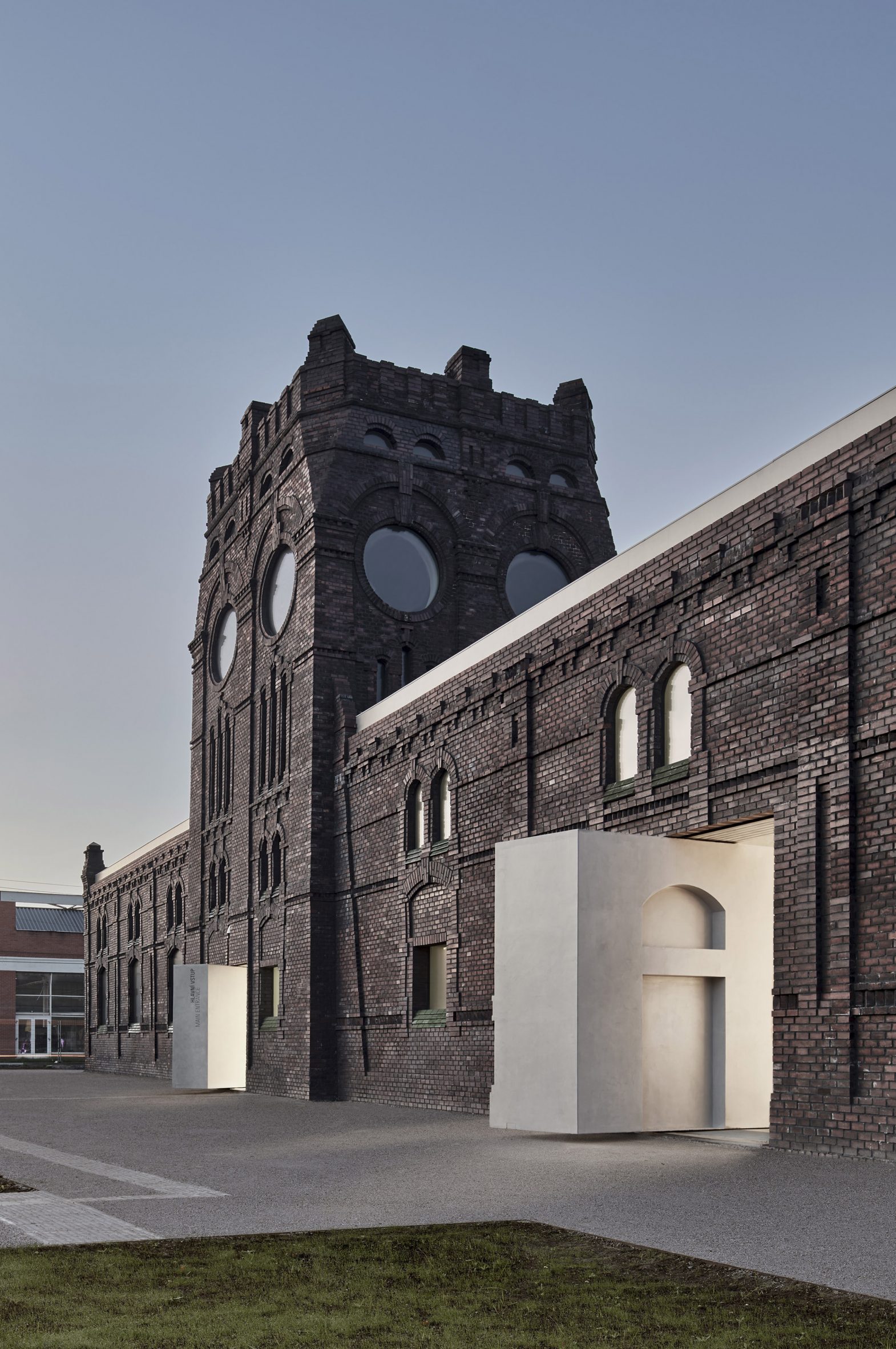


Architecture studio KWK Promes has converted a slaughterhouse in the Czech Republic into Plato Contemporary Art Gallery, with exhibition spaces lined with rotating concrete walls. Located in Ostrava, the original heritage-protected slaughterhouse building dates back to the 19th century, but after decades of disuse, it had become dilapidated and partially collapsed.






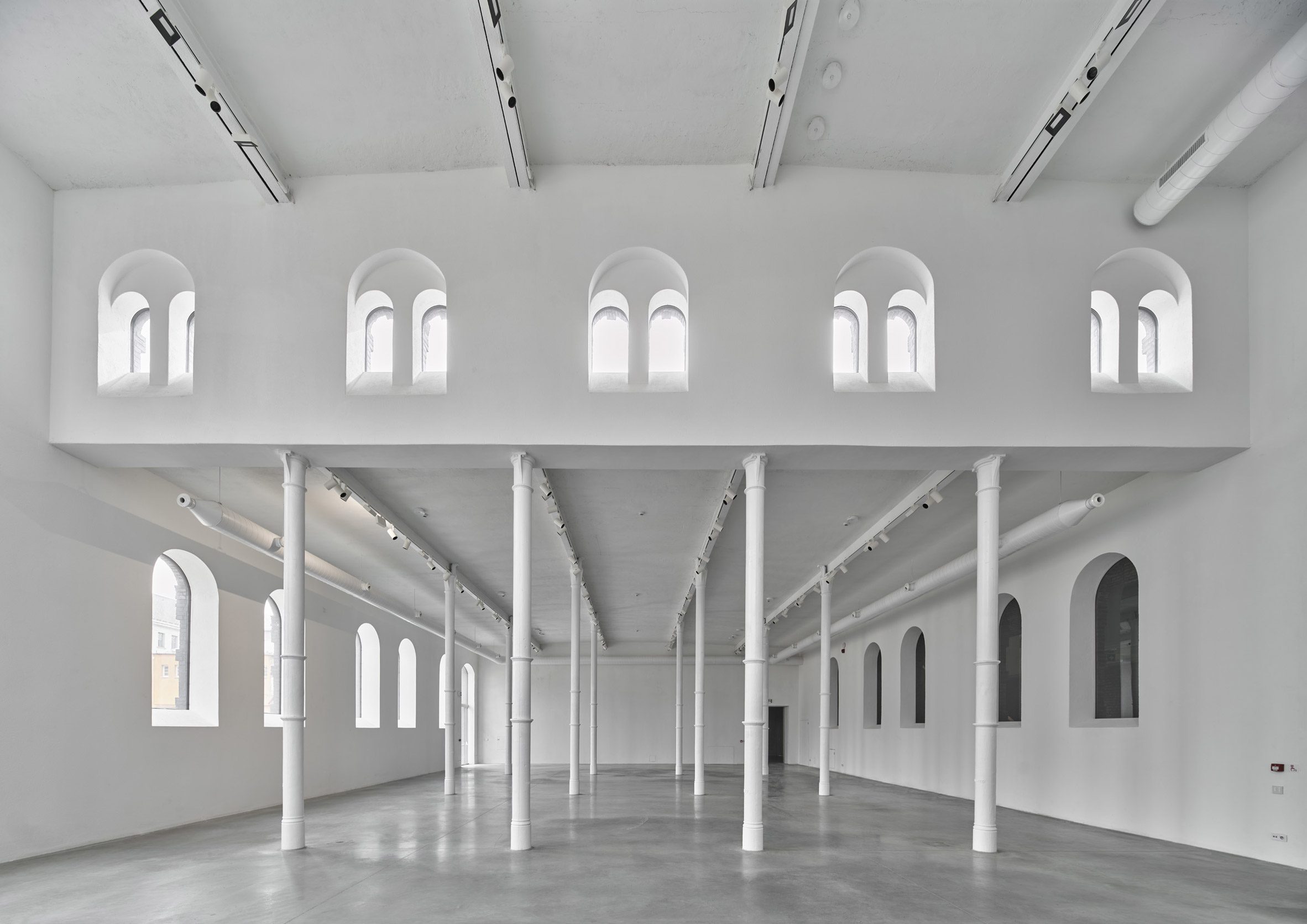
Tasked with adapting the structure into an art gallery, KWK Promes added an extension and concrete infills that contrast the existing sooty brickwork but mimic its ornamentation. These additions include six large rotating walls, three of which provide entry to Plato Contemporary Art Gallery and three that allow its exhibition spaces to be opened to the surroundings.






"We introduced a solution that makes art more democratic," explained the studio. "The main idea of the project is based on preserving the functionality of the openings as shortcuts connecting the building to the city," it added. "This has provided artists and curators with entirely new exhibition possibilities and allows art to literally 'go out' into the space around the building."
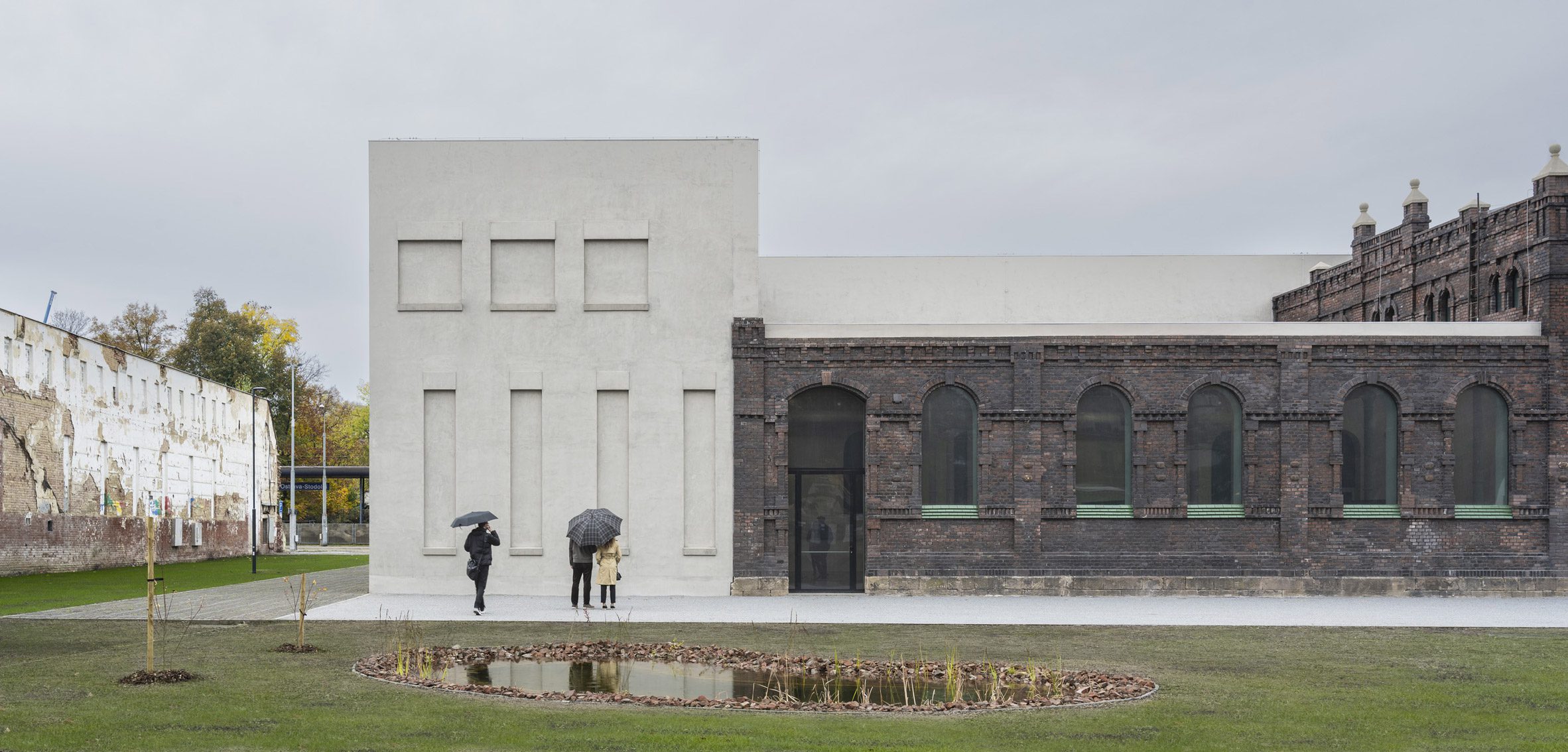

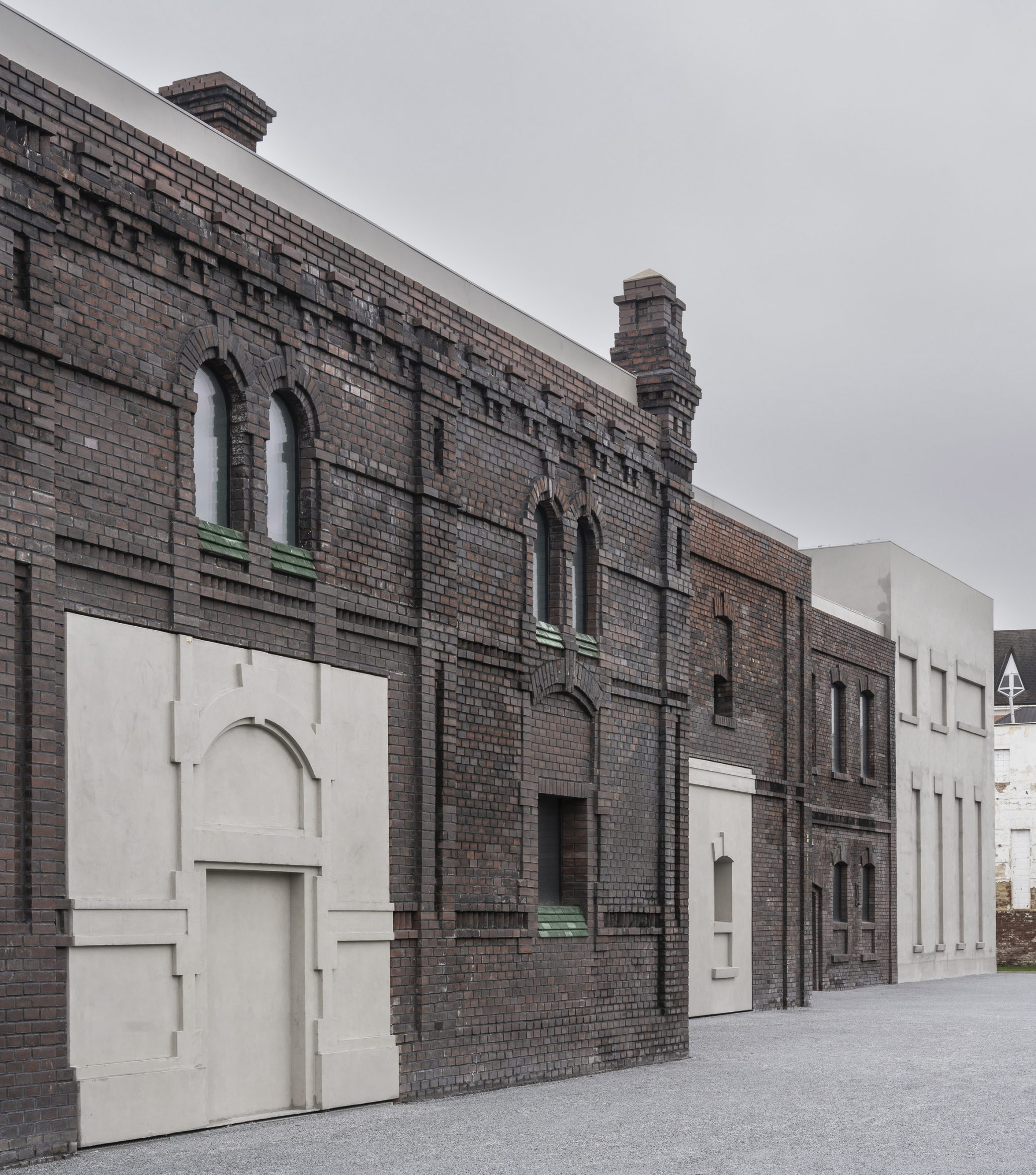



Plato Contemporary Art Gallery's rotating walls create two entrances on either side of the building, leading into a central reception, ticket office and cafe area. The four exhibition halls each sit on the ground floor around the edges of the building, allowing them to benefit from natural light and a connection to the surrounding park.
snip



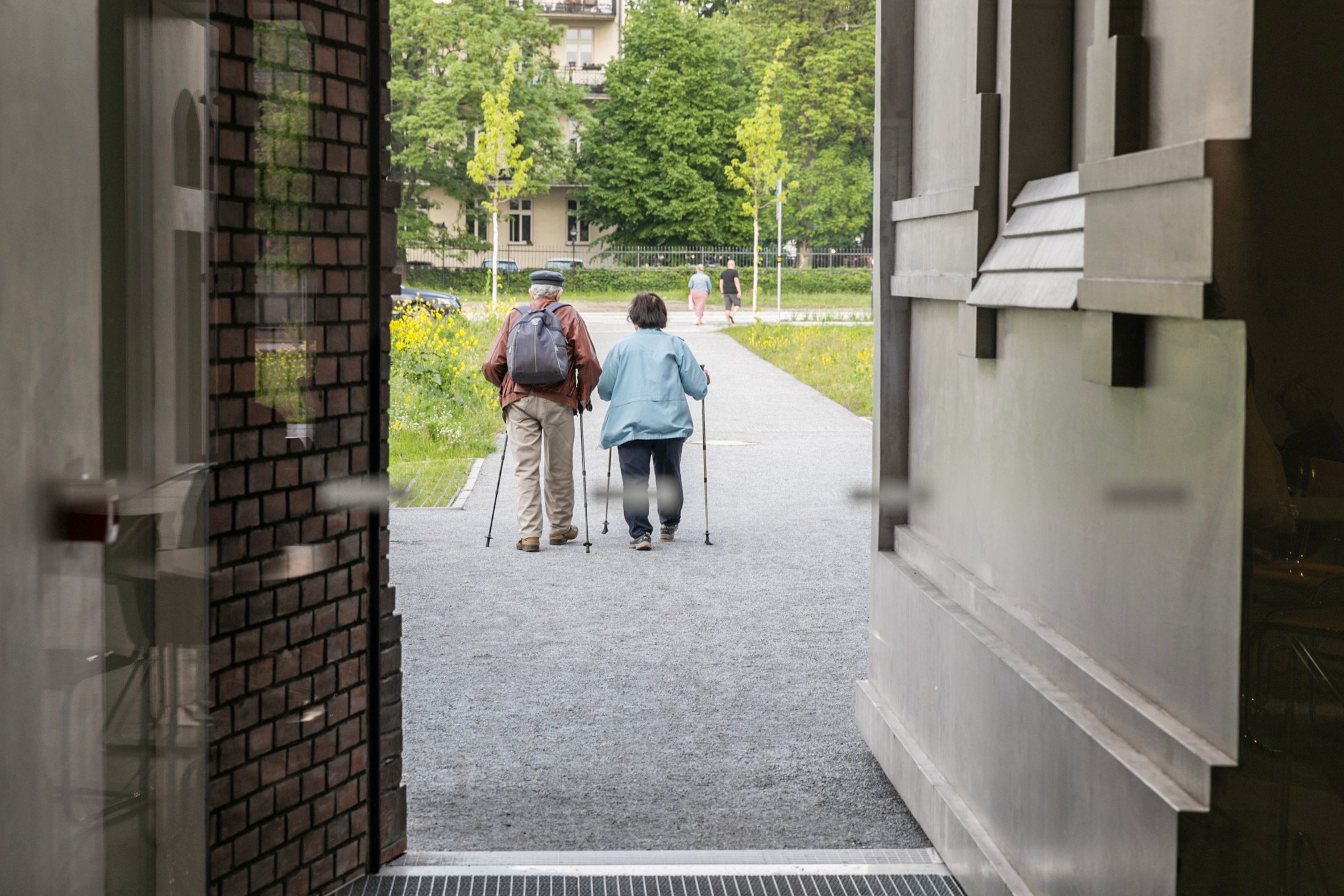







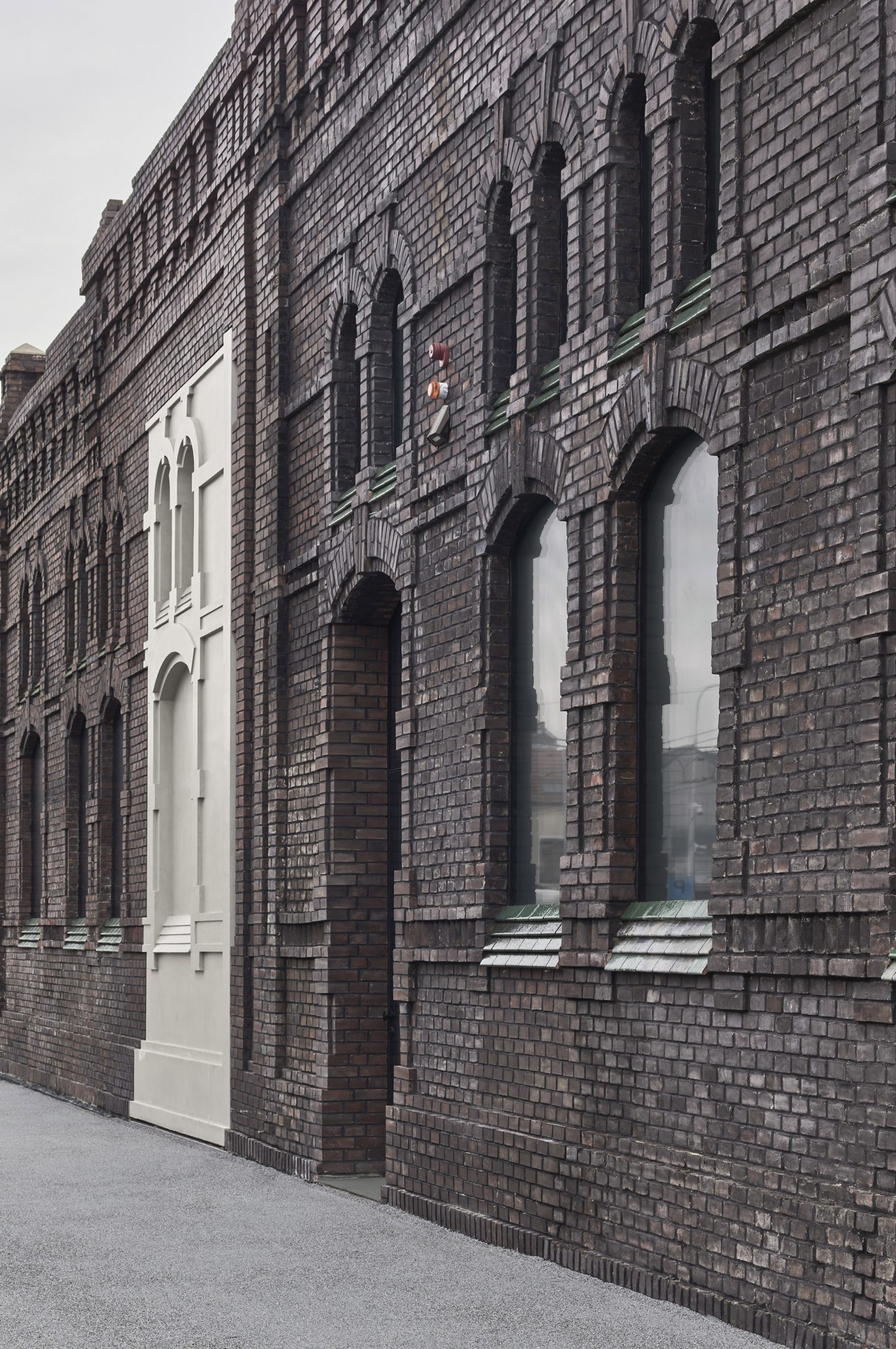




KWK Promes transforms Czech slaughterhouse into art gallery with rotating walls
https://www.dezeen.com/2024/04/28/plato-contemporary-art-gallery-kwk-promes/





Architecture studio KWK Promes has converted a slaughterhouse in the Czech Republic into Plato Contemporary Art Gallery, with exhibition spaces lined with rotating concrete walls. Located in Ostrava, the original heritage-protected slaughterhouse building dates back to the 19th century, but after decades of disuse, it had become dilapidated and partially collapsed.







Tasked with adapting the structure into an art gallery, KWK Promes added an extension and concrete infills that contrast the existing sooty brickwork but mimic its ornamentation. These additions include six large rotating walls, three of which provide entry to Plato Contemporary Art Gallery and three that allow its exhibition spaces to be opened to the surroundings.






"We introduced a solution that makes art more democratic," explained the studio. "The main idea of the project is based on preserving the functionality of the openings as shortcuts connecting the building to the city," it added. "This has provided artists and curators with entirely new exhibition possibilities and allows art to literally 'go out' into the space around the building."






Plato Contemporary Art Gallery's rotating walls create two entrances on either side of the building, leading into a central reception, ticket office and cafe area. The four exhibition halls each sit on the ground floor around the edges of the building, allowing them to benefit from natural light and a connection to the surrounding park.
snip
















April 30, 2024
Tracklist
[00:00] Zerb & Sofiya Nzau - Mwaki (Franky Wah Remix) [TH3RD BRAIN]
[04:15] Cristoph - Lost Witness [SUARA]
[08:15] Artaria & Saint Code - People Say So [SIONA]
[14:40] Alan Wools - Echoes Of The Night [SIONA]
[19:00] Super Flu & Dancing On Lego - Dear Friend [MONABERRY]
[24:00] Adriatique & Undercatt - Horizon [X RECORDINGS]
[28:30] Hidden Empire - Morjim At Night [SIONA]
[33:10] CamelPhat & Rhodes - Home (Vintage Culture Remix) [WHEN STARS ALIGN]
[37:00] Massano - Nodosuba [SIMULATE]
[41:40] Victor Garde & Döts - It's Killing Me [SIONA]
[46:35] Miss Monique - Bloom At Night [TOMORROWLAND MUSIC]
[51:50] Cherry - Mosaic [SIONA]
[56:15] Miss Monique - Look At You [INTERSTELLAR]
[1:00:00] Innellea - Under Earth [UNRELEASED]
[1:06:00] The Advocate - Losing Control [SIONA]
[1:11:30] EarthLife - Trasporto [SPECTRUM MUSIC]
[1:15:55] Dominik Gehringer - Strange World [PURIFIED]
[1:21:25] Disclosure ft. Eliza Doolittle - You & Me (Rivo Remix) [PMR]

Miss Monique @ Bali, Indonesia 2024 [Melodic Techno/ Progressive House DJ Mix]
Tracklist
[00:00] Zerb & Sofiya Nzau - Mwaki (Franky Wah Remix) [TH3RD BRAIN]
[04:15] Cristoph - Lost Witness [SUARA]
[08:15] Artaria & Saint Code - People Say So [SIONA]
[14:40] Alan Wools - Echoes Of The Night [SIONA]
[19:00] Super Flu & Dancing On Lego - Dear Friend [MONABERRY]
[24:00] Adriatique & Undercatt - Horizon [X RECORDINGS]
[28:30] Hidden Empire - Morjim At Night [SIONA]
[33:10] CamelPhat & Rhodes - Home (Vintage Culture Remix) [WHEN STARS ALIGN]
[37:00] Massano - Nodosuba [SIMULATE]
[41:40] Victor Garde & Döts - It's Killing Me [SIONA]
[46:35] Miss Monique - Bloom At Night [TOMORROWLAND MUSIC]
[51:50] Cherry - Mosaic [SIONA]
[56:15] Miss Monique - Look At You [INTERSTELLAR]
[1:00:00] Innellea - Under Earth [UNRELEASED]
[1:06:00] The Advocate - Losing Control [SIONA]
[1:11:30] EarthLife - Trasporto [SPECTRUM MUSIC]
[1:15:55] Dominik Gehringer - Strange World [PURIFIED]
[1:21:25] Disclosure ft. Eliza Doolittle - You & Me (Rivo Remix) [PMR]

April 30, 2024

https://www.washingtonpost.com/opinions/2024/04/29/ai-professional-class-low-skill-jobs/
https://archive.ph/4DULg

I was born in 1973, just as the American economy was going to hell — though I cannot accept all the blame. It was the twilight of the 20th-century manufacturing boom that had almost managed to compress the whole country into one vast middle class and, for reasons beyond my control, that boom was unraveling. Inflation was headed into double digits as labor productivity began to decline, economic growth swooned, unemployment rose and manufacturing employment tipped into the final descent toward its current sub-10 percent share. This turnaround devastated workers and communities, and even college-bound kids like me absorbed the sadness — through songs such as Bruce Springsteen’s “Born in the U.S.A.” and Billy Joel’s “Allentown,” through shows such as “Roseanne.” As we entered the electorate, it became a major force in our politics, as the Clintons tried to steer the economy toward a global, postindustrial future.
Voting for Bill Clinton, I believed his answers were correct. Trade and automation made Americans better off overall, even as they displaced some manufacturing workers. What we needed to do was finesse the adjustment, primarily by sending more kids to college to capitalize on the growing wage premium — 40 percent when I was born, 60 percent when I graduated college, and closer to 80 percent today. Older workers who weren’t ready to become college freshman could be retrained for booming service sector jobs. I still think our prescriptions were broadly correct. But as artificial intelligence starts coming for our jobs, I wonder how well the professional class will take its own medicine. Will we gracefully transition to lower-skilled service work, as we urged manufacturing workers to do? Or will we fight like hell to retain what we have, for our children as well as ourselves?
For I suspect AI is coming for a lot of professional class jobs, despite how many people I hear say a machine can never do what they do. We’re accustomed to think of automation as primarily displacing the working class, but as economist Daron Acemoglu wrote in 2002, “the idea that technological advances favor more skilled workers is a 20th-century phenomenon”; in the 19th century, steam-driven machines replaced a lot of skilled artisans, and AI currently looks to be pointed in a similar direction. If you work with words and symbols, AI can already do a surprising amount of what you can do — and it is improving with terrifying speed. As a Bloomberg News headline put it in February, “AI Is Driving More Layoffs Than Companies Want to Admit.” And though the numbers aren’t enormous — Bloomberg cites one source that found 4,600 AI-related layoffs during the previous nine months — that’s a pretty big number considering that ChatGPT was released to the public only in November 2022. It’s going to get bigger still.
As with previous rounds of automation, good jobs will be created as well as destroyed, and even those who don’t get them will enjoy broadly rising prosperity. But that was also true for manufacturing workers displaced by the China shock — as people like me kept telling them. A report last year from the Congressional Budget Office notes that though incomes “increased most among households in the highest quintile” between 1979 and 2020, average incomes increased in all quintiles. Yet as they kept telling us, people don’t care only about their role as consumers; they care about their role as producers and, more broadly, about their relative place in society. For the working class, that place has been eroding, in relative terms, for decades. The kinds of jobs many of them now occupy — in retail, say, or on the lower rungs of the health-care system — have less social status than the old manufacturing jobs even when they pay as well. And they often require a combination of servility and soft skills that wasn't demanded on an assembly line.
snip
AI is coming for the professional class. Expect outrage -- and fear.

https://www.washingtonpost.com/opinions/2024/04/29/ai-professional-class-low-skill-jobs/
https://archive.ph/4DULg

I was born in 1973, just as the American economy was going to hell — though I cannot accept all the blame. It was the twilight of the 20th-century manufacturing boom that had almost managed to compress the whole country into one vast middle class and, for reasons beyond my control, that boom was unraveling. Inflation was headed into double digits as labor productivity began to decline, economic growth swooned, unemployment rose and manufacturing employment tipped into the final descent toward its current sub-10 percent share. This turnaround devastated workers and communities, and even college-bound kids like me absorbed the sadness — through songs such as Bruce Springsteen’s “Born in the U.S.A.” and Billy Joel’s “Allentown,” through shows such as “Roseanne.” As we entered the electorate, it became a major force in our politics, as the Clintons tried to steer the economy toward a global, postindustrial future.
Voting for Bill Clinton, I believed his answers were correct. Trade and automation made Americans better off overall, even as they displaced some manufacturing workers. What we needed to do was finesse the adjustment, primarily by sending more kids to college to capitalize on the growing wage premium — 40 percent when I was born, 60 percent when I graduated college, and closer to 80 percent today. Older workers who weren’t ready to become college freshman could be retrained for booming service sector jobs. I still think our prescriptions were broadly correct. But as artificial intelligence starts coming for our jobs, I wonder how well the professional class will take its own medicine. Will we gracefully transition to lower-skilled service work, as we urged manufacturing workers to do? Or will we fight like hell to retain what we have, for our children as well as ourselves?
For I suspect AI is coming for a lot of professional class jobs, despite how many people I hear say a machine can never do what they do. We’re accustomed to think of automation as primarily displacing the working class, but as economist Daron Acemoglu wrote in 2002, “the idea that technological advances favor more skilled workers is a 20th-century phenomenon”; in the 19th century, steam-driven machines replaced a lot of skilled artisans, and AI currently looks to be pointed in a similar direction. If you work with words and symbols, AI can already do a surprising amount of what you can do — and it is improving with terrifying speed. As a Bloomberg News headline put it in February, “AI Is Driving More Layoffs Than Companies Want to Admit.” And though the numbers aren’t enormous — Bloomberg cites one source that found 4,600 AI-related layoffs during the previous nine months — that’s a pretty big number considering that ChatGPT was released to the public only in November 2022. It’s going to get bigger still.
As with previous rounds of automation, good jobs will be created as well as destroyed, and even those who don’t get them will enjoy broadly rising prosperity. But that was also true for manufacturing workers displaced by the China shock — as people like me kept telling them. A report last year from the Congressional Budget Office notes that though incomes “increased most among households in the highest quintile” between 1979 and 2020, average incomes increased in all quintiles. Yet as they kept telling us, people don’t care only about their role as consumers; they care about their role as producers and, more broadly, about their relative place in society. For the working class, that place has been eroding, in relative terms, for decades. The kinds of jobs many of them now occupy — in retail, say, or on the lower rungs of the health-care system — have less social status than the old manufacturing jobs even when they pay as well. And they often require a combination of servility and soft skills that wasn't demanded on an assembly line.
snip
April 30, 2024

https://www.washingtonpost.com/opinions/2024/04/30/drug-prices-medicare-biden-administration/
https://archive.ph/J6bUV

Thanks to the Inflation Reduction Act, one of President Biden’s signature achievements, prescription drugs are set to become substantially more affordable for seniors. Yet many Americans seem unaware of just how monumental these changes will be. Here are six things to look for:
1) Drug price negotiation. For the first time in history, Medicare can now negotiate directly with manufacturers. For the initial round of negotiations, the Centers for Medicare and Medicaid Services chose 10 drugs that treat common health conditions, including cardiovascular disease, cancer and rheumatoid arthritis. Each of these medications costs consumers in the United States three to eight times what people pay in other countries. In 2022, Medicare paid an eye-popping $46.4 billion for them. The impact to consumers is equally staggering. As CMS Administrator Chiquita Brooks-LaSure told me, “Some of these drugs are thousands of dollars per year for people who depend on them to live.”
It will take some time for negotiated prices to take effect. Assuming the federal government prevails in the lawsuits filed by pharmaceutical companies, CMS expects lower prices to be in place in 2026. But that’s only the beginning. Ten more drugs will be selected for 2026, going up to 15 for 2027 and then 20 per year from 2029and thereafter. The lower prices are projected to save the federal government $100 billion over the next several years. Crucially, this means that the negotiations won’t just benefit people who are on these specific medications; the savings are passed along, indirectly, to everyone on Medicare.
2) A cap on out-of-pocket spending. While the IRA’s price negotiation provision has garnered the lion’s share of media attention, this change will have the most direct consequence for most seniors. In 2025, everyone with Medicare’s prescription drug benefit, called Part D, will pay no more than $2,000 per year out of pocket for medications. CMS projects that nearly 19 million seniors will save an average of $400 per year. But this number alone does not tell the full story. Brooks-LaSure shared with me that she recently met a woman with leukemia. “She’s spending $12,000, which was 13 percent of her gross income, just for one drug,” she said.
snip
6 ways the Biden administration is lowering drug prices for seniors

https://www.washingtonpost.com/opinions/2024/04/30/drug-prices-medicare-biden-administration/
https://archive.ph/J6bUV

Thanks to the Inflation Reduction Act, one of President Biden’s signature achievements, prescription drugs are set to become substantially more affordable for seniors. Yet many Americans seem unaware of just how monumental these changes will be. Here are six things to look for:
1) Drug price negotiation. For the first time in history, Medicare can now negotiate directly with manufacturers. For the initial round of negotiations, the Centers for Medicare and Medicaid Services chose 10 drugs that treat common health conditions, including cardiovascular disease, cancer and rheumatoid arthritis. Each of these medications costs consumers in the United States three to eight times what people pay in other countries. In 2022, Medicare paid an eye-popping $46.4 billion for them. The impact to consumers is equally staggering. As CMS Administrator Chiquita Brooks-LaSure told me, “Some of these drugs are thousands of dollars per year for people who depend on them to live.”
It will take some time for negotiated prices to take effect. Assuming the federal government prevails in the lawsuits filed by pharmaceutical companies, CMS expects lower prices to be in place in 2026. But that’s only the beginning. Ten more drugs will be selected for 2026, going up to 15 for 2027 and then 20 per year from 2029and thereafter. The lower prices are projected to save the federal government $100 billion over the next several years. Crucially, this means that the negotiations won’t just benefit people who are on these specific medications; the savings are passed along, indirectly, to everyone on Medicare.
2) A cap on out-of-pocket spending. While the IRA’s price negotiation provision has garnered the lion’s share of media attention, this change will have the most direct consequence for most seniors. In 2025, everyone with Medicare’s prescription drug benefit, called Part D, will pay no more than $2,000 per year out of pocket for medications. CMS projects that nearly 19 million seniors will save an average of $400 per year. But this number alone does not tell the full story. Brooks-LaSure shared with me that she recently met a woman with leukemia. “She’s spending $12,000, which was 13 percent of her gross income, just for one drug,” she said.
snip
April 30, 2024

https://www.washingtonpost.com/opinions/2024/04/29/columbia-protest-antisemitism-encampment-free-speech/
https://archive.ph/TYxhu
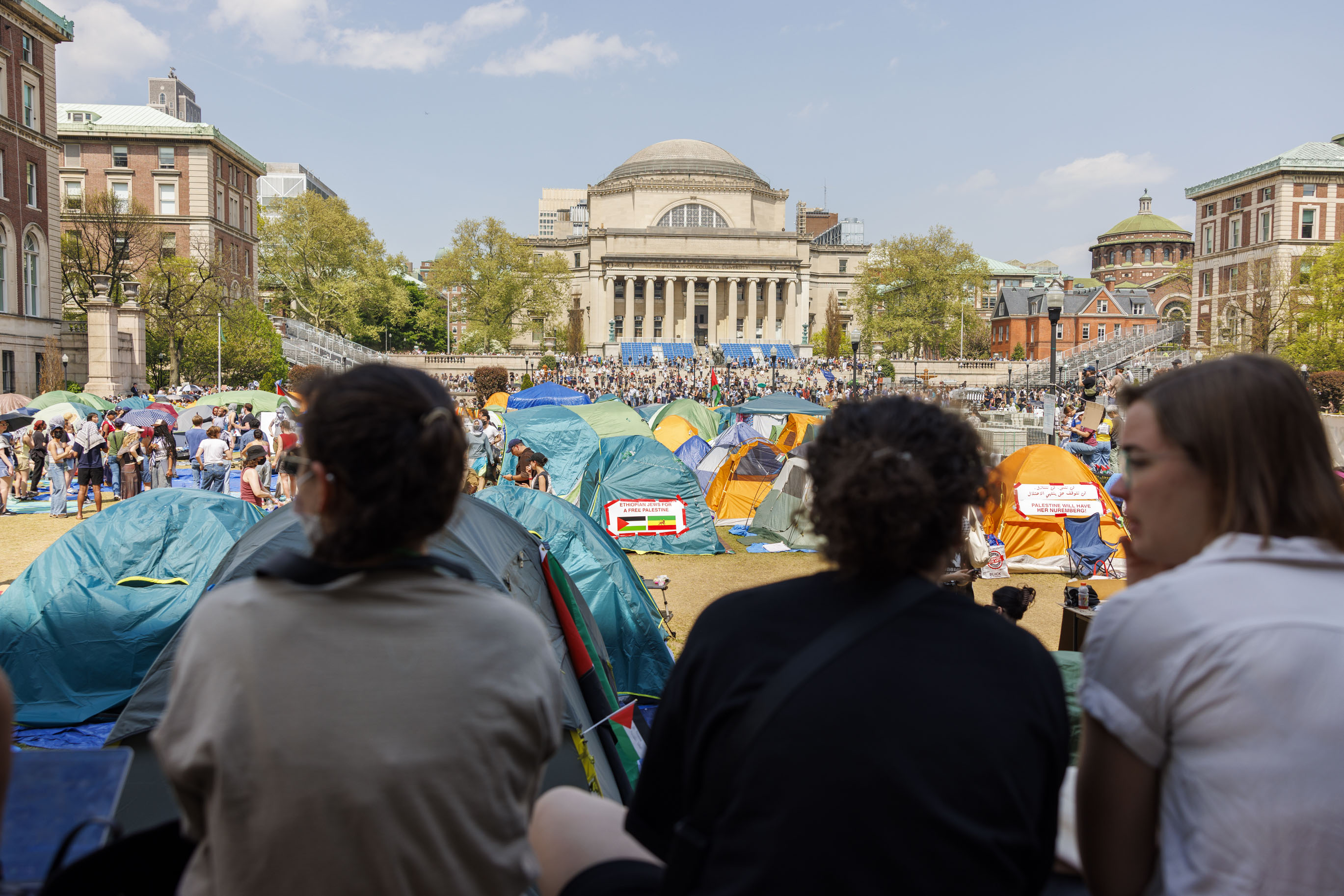
Many students and others on and around college campuses — including before the recent wave of demonstrations — have peacefully exercised their right to oppose what they consider Israel’s wrongful conduct in Gaza, as well as U.S. support for the Jewish state. Like many Americans, they find the terrible human costs of the Israel Defense Forces’ response to the Oct. 7 Hamas massacre — more than 34,000 mostly civilian Palestinians dead, destroyed infrastructure, mass displacement and a humanitarian crisis — militarily and morally unjustified. On too many occasions, however, protests have veered from legitimate concerns into antisemitism. Calling for a cease-fire and recognition of a Palestinian state is one thing. Celebrating or rationalizing the horrific violence of Oct. 7, or cheering on Hamas or other extremist groups, is quite another.
At some campuses, Jewish students, staff and faculty understandably feel intimidated and unwelcome. To cite a few examples from one protest hotbed, Columbia University in New York and its environs: Jews have been told “go back to Poland” and subjected to a handheld sign labeling them the Hamas military wing’s “next targets.” Jewish students were surrounded and pushed back by a student human chain, on instructions of a leading activist who warned that “Zionists” had “entered the encampment” — which protesters had set up in a public area. That activist, Khymani James, had previously told Columbia administrators that “Zionists don’t deserve to live” and suggested they should “be grateful that I’m not just going out and murdering Zionists.” (Three-month-old video of the meeting recently became public; Mr. James disavowed his comments only after they went viral.)
The worst expressions are not necessarily representative of all protesters, who themselves make up just a small fraction of students and young people generally. But any human rights movement worthy of the name should practice zero tolerance of antisemitism, period. This is cause for profound reflection by the protesters. Antisemitism is repugnant and contrary to democratic values; authorities who condemn it are making good use of their right to “counterspeech.” Beyond that, however, what should they do? Free expression, too, is essential to democracy. With very limited exceptions, people in the United States have the right to sing, write and say what they want, even if others find their language offensive or hateful. Illiberal official action is the wrong response to illiberal words.
Fortunately, the Constitution, as interpreted by the Supreme Court, provides guidance that is both balanced and eminently workable. The First Amendment protects even highly objectionable or bigoted speech — short of actual harassment, threats or incitement to violence. And it allows provocative demonstrations, subject to rational, narrowly tailored limitations on how, when and where they occur. Rules must be enforced evenhandedly, in what the court has called a “viewpoint-neutral” manner. (If only university leaders had not previously tilted, selectively, against speakers who contravene progressive norms, or equivocated about antisemitic rhetoric at congressional hearings.)
snip
How to confront antisemitism, deal with protests -- and respect free speech

https://www.washingtonpost.com/opinions/2024/04/29/columbia-protest-antisemitism-encampment-free-speech/
https://archive.ph/TYxhu

Many students and others on and around college campuses — including before the recent wave of demonstrations — have peacefully exercised their right to oppose what they consider Israel’s wrongful conduct in Gaza, as well as U.S. support for the Jewish state. Like many Americans, they find the terrible human costs of the Israel Defense Forces’ response to the Oct. 7 Hamas massacre — more than 34,000 mostly civilian Palestinians dead, destroyed infrastructure, mass displacement and a humanitarian crisis — militarily and morally unjustified. On too many occasions, however, protests have veered from legitimate concerns into antisemitism. Calling for a cease-fire and recognition of a Palestinian state is one thing. Celebrating or rationalizing the horrific violence of Oct. 7, or cheering on Hamas or other extremist groups, is quite another.
At some campuses, Jewish students, staff and faculty understandably feel intimidated and unwelcome. To cite a few examples from one protest hotbed, Columbia University in New York and its environs: Jews have been told “go back to Poland” and subjected to a handheld sign labeling them the Hamas military wing’s “next targets.” Jewish students were surrounded and pushed back by a student human chain, on instructions of a leading activist who warned that “Zionists” had “entered the encampment” — which protesters had set up in a public area. That activist, Khymani James, had previously told Columbia administrators that “Zionists don’t deserve to live” and suggested they should “be grateful that I’m not just going out and murdering Zionists.” (Three-month-old video of the meeting recently became public; Mr. James disavowed his comments only after they went viral.)
The worst expressions are not necessarily representative of all protesters, who themselves make up just a small fraction of students and young people generally. But any human rights movement worthy of the name should practice zero tolerance of antisemitism, period. This is cause for profound reflection by the protesters. Antisemitism is repugnant and contrary to democratic values; authorities who condemn it are making good use of their right to “counterspeech.” Beyond that, however, what should they do? Free expression, too, is essential to democracy. With very limited exceptions, people in the United States have the right to sing, write and say what they want, even if others find their language offensive or hateful. Illiberal official action is the wrong response to illiberal words.
Fortunately, the Constitution, as interpreted by the Supreme Court, provides guidance that is both balanced and eminently workable. The First Amendment protects even highly objectionable or bigoted speech — short of actual harassment, threats or incitement to violence. And it allows provocative demonstrations, subject to rational, narrowly tailored limitations on how, when and where they occur. Rules must be enforced evenhandedly, in what the court has called a “viewpoint-neutral” manner. (If only university leaders had not previously tilted, selectively, against speakers who contravene progressive norms, or equivocated about antisemitic rhetoric at congressional hearings.)
snip
April 30, 2024
In a bold sermon that has gone viral, Pastor Loran Livingston of Central Church in Charlotte, North Carolina, delivers a powerful rebuke against the “God Bless the USA Bible,” endorsed by former President Donald Trump. Calling it “disgusting” and “blasphemous,” Pastor Livingston warns against the dangers of intertwining scripture with political symbols like the Constitution and Bill of Rights.
Charlotte evangelical pastor in national spotlight, called Trump Bible ‘disgusting’
https://www.charlotteobserver.com/news/politics-government/article288076880.html
A Charlotte evangelical pastor is in the national spotlight for a fire-and-brimstone sermon denouncing as “blasphemous” and “disgusting” what’s become known as the Trump Bible. Evangelicals are among the former president’s strongest backers, but Rev. Loran Livingston, the senior pastor of Central Church on Sardis Road condemned the Trump-endorsed “God Bless the USA Bible,” priced at $59.99. His April 14 sermon has drawn millions of views on social media. The bible homepage features a photo of a smiling Trump seated at what appears to be the Oval Office desk, although the website says Trump does not profit from sales of the book. Well, maybe with his base he does, but not with Livingston.
“ARE YOU KIDDING ME?”
The Trump Bible includes copies of the Constitution, Declaration of Independence, Bill of Rights, Pledge of Allegiance and the handwritten chorus to the song featured at Trump rallies: country singer Lee Greenwood’s “God Bless the USA.” Don’t fall for it, Livingston warned his flock at the packed 10:30 a.m. service. “When you don’t read and pray, you say, ‘Wow, there’s a Bible out now that includes the Constitution and the Bill of Rights, isn’t that wonderful?’ ” he said. “No!” he shouted. “It’s disgusting. It’s blasphemous. It’s a ploy. Are you kidding me? Some of you are so encouraged by that?” “The gospel is not an American gospel,” he said. “It is the Gospel of the Lord Jesus Christ.”
MIXING POLITICS AND CHURCH
“People that don’t read (the Bible) and pray will get politics mixed up with church,” Livingston said in his sermon that’s on his congregation’s YouTube site. “Some of you bring politics into the Church. You think that politics is spiritual stuff.” “No!” he said. “Your duty is to serve the Lord your God with all your heart, mind, soul, body and strength, and love your neighbor as yourself.” Livingston couldn’t be reached by The Charlotte Observer on Saturday. If you read the bible, he said, you’d also know that voting is not a “spiritual responsibility.” “My real citizenship is in heaven, from which we look for the Lord Jesus Christ,” Livingston said.
“BEND POLITICS TO THEOLOGY”
Livingston joins at least one nationally prominent Christian conservative to rebuke the Trump Bible: Andrew Walker of the Southern Baptist Theological Seminary, The Christian Post reported. “To put matters bluntly, a Bible like this should never have been made,” Walker wrote March 28 in the Christian publication World, quickly adding that he’s both pro-Bible and pro-Constitution. “The Bible is not a symbol of American identity even while we proudly herald the Bible-influenced shape of American life and values,” Walker wrote. “There is an ever-present temptation to allow one’s theology to bend to one’s politics when it is our politics that should bend to our theology.”
snip
'It's Disgusting, Blasphemous'! Megachurch Pastor Rebukes Trump Endorsed Bible
In a bold sermon that has gone viral, Pastor Loran Livingston of Central Church in Charlotte, North Carolina, delivers a powerful rebuke against the “God Bless the USA Bible,” endorsed by former President Donald Trump. Calling it “disgusting” and “blasphemous,” Pastor Livingston warns against the dangers of intertwining scripture with political symbols like the Constitution and Bill of Rights.
Charlotte evangelical pastor in national spotlight, called Trump Bible ‘disgusting’
https://www.charlotteobserver.com/news/politics-government/article288076880.html
A Charlotte evangelical pastor is in the national spotlight for a fire-and-brimstone sermon denouncing as “blasphemous” and “disgusting” what’s become known as the Trump Bible. Evangelicals are among the former president’s strongest backers, but Rev. Loran Livingston, the senior pastor of Central Church on Sardis Road condemned the Trump-endorsed “God Bless the USA Bible,” priced at $59.99. His April 14 sermon has drawn millions of views on social media. The bible homepage features a photo of a smiling Trump seated at what appears to be the Oval Office desk, although the website says Trump does not profit from sales of the book. Well, maybe with his base he does, but not with Livingston.
“ARE YOU KIDDING ME?”
The Trump Bible includes copies of the Constitution, Declaration of Independence, Bill of Rights, Pledge of Allegiance and the handwritten chorus to the song featured at Trump rallies: country singer Lee Greenwood’s “God Bless the USA.” Don’t fall for it, Livingston warned his flock at the packed 10:30 a.m. service. “When you don’t read and pray, you say, ‘Wow, there’s a Bible out now that includes the Constitution and the Bill of Rights, isn’t that wonderful?’ ” he said. “No!” he shouted. “It’s disgusting. It’s blasphemous. It’s a ploy. Are you kidding me? Some of you are so encouraged by that?” “The gospel is not an American gospel,” he said. “It is the Gospel of the Lord Jesus Christ.”
MIXING POLITICS AND CHURCH
“People that don’t read (the Bible) and pray will get politics mixed up with church,” Livingston said in his sermon that’s on his congregation’s YouTube site. “Some of you bring politics into the Church. You think that politics is spiritual stuff.” “No!” he said. “Your duty is to serve the Lord your God with all your heart, mind, soul, body and strength, and love your neighbor as yourself.” Livingston couldn’t be reached by The Charlotte Observer on Saturday. If you read the bible, he said, you’d also know that voting is not a “spiritual responsibility.” “My real citizenship is in heaven, from which we look for the Lord Jesus Christ,” Livingston said.
“BEND POLITICS TO THEOLOGY”
Livingston joins at least one nationally prominent Christian conservative to rebuke the Trump Bible: Andrew Walker of the Southern Baptist Theological Seminary, The Christian Post reported. “To put matters bluntly, a Bible like this should never have been made,” Walker wrote March 28 in the Christian publication World, quickly adding that he’s both pro-Bible and pro-Constitution. “The Bible is not a symbol of American identity even while we proudly herald the Bible-influenced shape of American life and values,” Walker wrote. “There is an ever-present temptation to allow one’s theology to bend to one’s politics when it is our politics that should bend to our theology.”
snip
April 30, 2024

Pro-Palestinian student activists say their movement is anti-Zionist but not antisemitic. It is not a distinction that everyone accepts.
https://www.nytimes.com/2024/04/29/nyregion/college-protests-columbia-campus.html
https://archive.ph/YGHvh

Columbia’s “Gaza Solidarity Encampment” has inspired a national student movement against Israel’s treatment of Palestinians. Credit...Juan Arredondo for The New York Times
In a video shared widely online, a leader of the pro-Palestinian student movement at Columbia University stands near the center of a lawn on the campus and calls out, “We have Zionists who have entered the camp.” Dozens of protesters, who have created a tent village called the “Gaza Solidarity Encampment,” repeat his words back to him: “We have Zionists who have entered the camp.” “Walk and take a step forward,” the leader says, as the students continue to repeat his every utterance, “so that we can start to push them out of the camp.” The protesters link arms and march in formation toward three Jewish students who have come inside the encampment.
https://twitter.com/jessicaschwalb7/status/1782252789625663770
“It was really scary because we had like 75 people quickly gathered around, encircling us, doing exactly what he said to do,” Avi Weinberg, one of the Jewish students, said in an interview. He and his friends had gone to see the encampment, not intending to provoke, he said. When it began to feel tense, one of the students started to record the encounter. They are not sure precisely how the protest leader determined they were supportive of Israel. “Suddenly we are being called ‘the Zionists’ in their encampment,” Mr. Weinberg said. “He put a target on our back.”
On Thursday, the incident took on new significance when a video from January resurfaced on social media showing the same protest leader, Khymani James, saying “Zionists don’t deserve to live” and “Be grateful that I’m not just going out and murdering Zionists.” The next day, Columbia officials announced they had barred Mr. James from campus. Columbia has been ground zero in a national student movement against Israel’s treatment of Palestinians, with protesters setting up encampments on campuses across the country. Hundreds of demonstrators — at Columbia, Yale, Emerson College, the University of Southern California and beyond — have been arrested.

Pro-Palestinian demonstrators across the country say Israel is committing what they see as genocide against the Palestinian people, and they aim to keep a spotlight on the suffering. But some Jewish students who support Israel and what they see as its right to defend itself against Hamas say the protests have made them afraid to walk freely on campus. They hear denunciations of Zionism and calls for a Palestinian uprising as an attack on Jews themselves. The tension goes to the heart of a question that has touched off debate among observers and critics of the protests: At what point does pro-Palestinian political speech in a time of war cross the line into the type of antisemitism colleges have vowed to combat?
snip
Universities Face an Urgent Question: What Makes a Protest Antisemitic?

Pro-Palestinian student activists say their movement is anti-Zionist but not antisemitic. It is not a distinction that everyone accepts.
https://www.nytimes.com/2024/04/29/nyregion/college-protests-columbia-campus.html
https://archive.ph/YGHvh

Columbia’s “Gaza Solidarity Encampment” has inspired a national student movement against Israel’s treatment of Palestinians. Credit...Juan Arredondo for The New York Times
In a video shared widely online, a leader of the pro-Palestinian student movement at Columbia University stands near the center of a lawn on the campus and calls out, “We have Zionists who have entered the camp.” Dozens of protesters, who have created a tent village called the “Gaza Solidarity Encampment,” repeat his words back to him: “We have Zionists who have entered the camp.” “Walk and take a step forward,” the leader says, as the students continue to repeat his every utterance, “so that we can start to push them out of the camp.” The protesters link arms and march in formation toward three Jewish students who have come inside the encampment.
https://twitter.com/jessicaschwalb7/status/1782252789625663770
“It was really scary because we had like 75 people quickly gathered around, encircling us, doing exactly what he said to do,” Avi Weinberg, one of the Jewish students, said in an interview. He and his friends had gone to see the encampment, not intending to provoke, he said. When it began to feel tense, one of the students started to record the encounter. They are not sure precisely how the protest leader determined they were supportive of Israel. “Suddenly we are being called ‘the Zionists’ in their encampment,” Mr. Weinberg said. “He put a target on our back.”
On Thursday, the incident took on new significance when a video from January resurfaced on social media showing the same protest leader, Khymani James, saying “Zionists don’t deserve to live” and “Be grateful that I’m not just going out and murdering Zionists.” The next day, Columbia officials announced they had barred Mr. James from campus. Columbia has been ground zero in a national student movement against Israel’s treatment of Palestinians, with protesters setting up encampments on campuses across the country. Hundreds of demonstrators — at Columbia, Yale, Emerson College, the University of Southern California and beyond — have been arrested.

Pro-Palestinian demonstrators across the country say Israel is committing what they see as genocide against the Palestinian people, and they aim to keep a spotlight on the suffering. But some Jewish students who support Israel and what they see as its right to defend itself against Hamas say the protests have made them afraid to walk freely on campus. They hear denunciations of Zionism and calls for a Palestinian uprising as an attack on Jews themselves. The tension goes to the heart of a question that has touched off debate among observers and critics of the protests: At what point does pro-Palestinian political speech in a time of war cross the line into the type of antisemitism colleges have vowed to combat?
snip
April 30, 2024

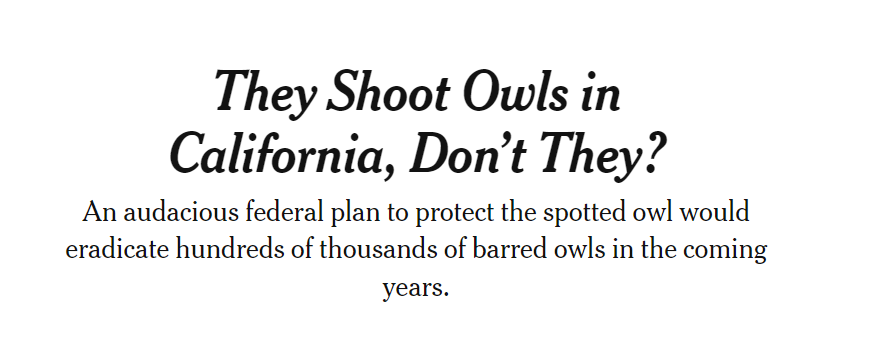
https://www.nytimes.com/2024/04/29/science/california-barred-spotted-owls.html
https://archive.ph/nBDwO

Northern spotted owl populations have declined by up to 80 percent over the last two decades. As few as 3,000 remain on federal lands, compared with 12,000 in the 1990s. Credit...Gerry Ellis/Minden Pictures
In the ancient forests of the Pacific Northwest, the northern spotted owl, a rare and fragile subspecies of spotted owl, is being muscled out of its limited habitat by the barred owl, its larger and more ornery northeastern cousin. The opportunistic barred owl has been moving in on spotted owl turf for more than half a century, competing with the locals for food and space, outnumbering, out-reproducing and inevitably chasing them out of their nesting spots. Barred owls have also emerged as a threat to the California spotted owl, a closely related subspecies in the Sierra Nevada and the mountains of coastal and Southern California.

A barred owl in New York in 2021. Credit...Dave Sanders for The New York Times
Crammed into marginal territories and bedeviled by wildfires, northern spotted owl populations have declined by up to 80 percent over the last two decades. As few as 3,000 remain on federal lands, compared with 11,000 in 1993. In the wilds of British Columbia, the northern spotted owl has vanished; only one, a female, remains. If the trend continues, the northern spotted owl could become the first owl subspecies in the United States to go extinct.

A northern spotted owl protecting its nest during the release of two captive-born chicks near Roseburg, Ore., in 2003. Credit...Rob Kerr
In a last-ditch effort to rescue the northern spotted owl from oblivion and protect the California spotted owl population, the U.S. Fish and Wildlife Service has proposed culling a staggering number of barred owls across a swath of 11 to 14 million acres in Washington, Oregon and Northern California, where barred owls — which the agency regards as invasive — are encroaching. The lethal management plan calls for eradicating up to half a million barred owls over the next 30 years, or 30 percent of the population over that time frame. The owls would be dispatched using the cheapest and most efficient methods, from large-bore shotguns with night scopes to capture and euthanasia.

David Wiens, a biologist with the U.S. Geological Survey, in a forest near Corvallis, Ore., in 2018. He carries a digital bird-calling device intended to attract barred owls to be culled. Credit...Ted S. Warren/Associated Press
Karla Bloem, the executive director of the International Owl Center in Minnesota, is conflicted over the prospect of killing one species to protect another. “The concept of shooting birds is awful — nobody wants that,” she said. “But none of the alternatives have worked, and at this late date no other option is viable. Extinction is a forever thing.” Bob Sallinger, the executive director of Bird Conservation Oregon, agreed but emphasized that the culling must complement the restoration and preservation of the few remaining old-growth forests. “The science clearly shows that you must both protect and increase habitat and remove some level of barred owls if the northern spotted owl is to have a chance of survival,” he said.
snip
They Shoot Owls in California, Don't They?


https://www.nytimes.com/2024/04/29/science/california-barred-spotted-owls.html
https://archive.ph/nBDwO

Northern spotted owl populations have declined by up to 80 percent over the last two decades. As few as 3,000 remain on federal lands, compared with 12,000 in the 1990s. Credit...Gerry Ellis/Minden Pictures
In the ancient forests of the Pacific Northwest, the northern spotted owl, a rare and fragile subspecies of spotted owl, is being muscled out of its limited habitat by the barred owl, its larger and more ornery northeastern cousin. The opportunistic barred owl has been moving in on spotted owl turf for more than half a century, competing with the locals for food and space, outnumbering, out-reproducing and inevitably chasing them out of their nesting spots. Barred owls have also emerged as a threat to the California spotted owl, a closely related subspecies in the Sierra Nevada and the mountains of coastal and Southern California.

A barred owl in New York in 2021. Credit...Dave Sanders for The New York Times
Crammed into marginal territories and bedeviled by wildfires, northern spotted owl populations have declined by up to 80 percent over the last two decades. As few as 3,000 remain on federal lands, compared with 11,000 in 1993. In the wilds of British Columbia, the northern spotted owl has vanished; only one, a female, remains. If the trend continues, the northern spotted owl could become the first owl subspecies in the United States to go extinct.

A northern spotted owl protecting its nest during the release of two captive-born chicks near Roseburg, Ore., in 2003. Credit...Rob Kerr
In a last-ditch effort to rescue the northern spotted owl from oblivion and protect the California spotted owl population, the U.S. Fish and Wildlife Service has proposed culling a staggering number of barred owls across a swath of 11 to 14 million acres in Washington, Oregon and Northern California, where barred owls — which the agency regards as invasive — are encroaching. The lethal management plan calls for eradicating up to half a million barred owls over the next 30 years, or 30 percent of the population over that time frame. The owls would be dispatched using the cheapest and most efficient methods, from large-bore shotguns with night scopes to capture and euthanasia.

David Wiens, a biologist with the U.S. Geological Survey, in a forest near Corvallis, Ore., in 2018. He carries a digital bird-calling device intended to attract barred owls to be culled. Credit...Ted S. Warren/Associated Press
Karla Bloem, the executive director of the International Owl Center in Minnesota, is conflicted over the prospect of killing one species to protect another. “The concept of shooting birds is awful — nobody wants that,” she said. “But none of the alternatives have worked, and at this late date no other option is viable. Extinction is a forever thing.” Bob Sallinger, the executive director of Bird Conservation Oregon, agreed but emphasized that the culling must complement the restoration and preservation of the few remaining old-growth forests. “The science clearly shows that you must both protect and increase habitat and remove some level of barred owls if the northern spotted owl is to have a chance of survival,” he said.
snip
Profile Information
Gender: FemaleHometown: London
Home country: US/UK/Sweden
Current location: Stockholm, Sweden
Member since: Sun Jul 1, 2018, 07:25 PM
Number of posts: 43,464